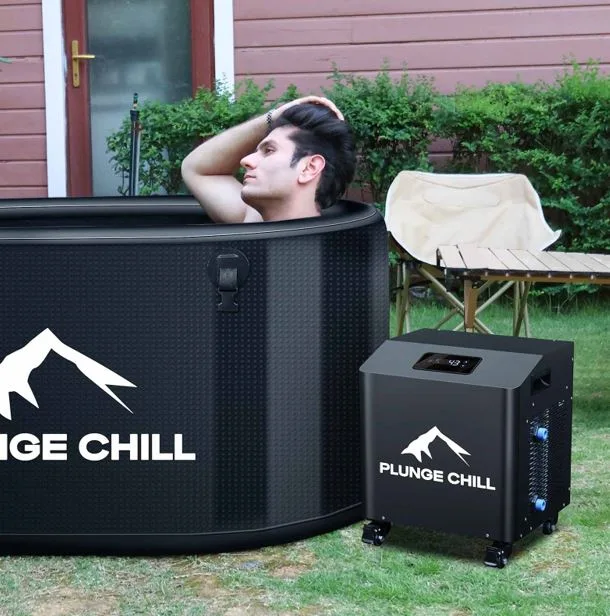Unlock Faster Recovery with Cold Plunge Water Chiller Benefits
Every athlete knows the feeling: muscles screaming after an intense training session, soreness that lingers for days, and the frustration of waiting for your body to catch up with your ambitions. Traditional recovery methods like stretching and rest often leave you sidelined longer than necessary, directly impacting your performance potential. Cold plunge therapy has emerged as a powerful solution, and when enhanced with precision water chillers, it transforms recovery from a passive waiting game into an active performance advantage. By immersing yourself in controlled cold water, you trigger physiological responses that accelerate muscle repair, dramatically reduce inflammation, and slash recovery time between sessions. This article explores how cold plunge water chillers deliver consistent, science-backed benefits that ice baths simply can’t match. You’ll discover the mechanisms behind cold therapy’s effectiveness, learn practical setup strategies for any budget or space, and master protocols that professional athletes use to maintain peak performance. Whether you’re a competitive athlete or serious fitness enthusiast, understanding these recovery tools can be the difference between plateauing and breaking through to your next level.
The Science of Cold Therapy for Athletic Recovery
When you submerge your body in cold water, you initiate a cascade of biological responses that directly combat the damage caused by intense training. Cold exposure constricts blood vessels, reducing blood flow to muscles and effectively limiting the inflammatory response that causes swelling and pain. Once you exit the cold plunge, blood vessels dilate rapidly, flushing metabolic waste products like lactic acid from muscle tissue while delivering oxygen-rich blood that accelerates cellular repair. This mechanism explains why athletes using cold therapy consistently report reduced delayed onset muscle soreness, with research showing up to 20% faster recovery compared to passive rest alone. Studies published in sports medicine journals demonstrate that athletes incorporating regular cold immersion reduce DOMS intensity by significant margins, allowing them to train at higher volumes without accumulating fatigue. The temperature shock also triggers the release of norepinephrine, a hormone that sharpens mental focus while providing natural pain relief. Unlike passive recovery methods such as simply resting or light stretching, cold therapy actively intervenes in the inflammatory process at the cellular level. Traditional approaches allow inflammation to run its natural course over several days, but controlled cold exposure compresses this timeline, enabling athletes to return to peak performance 24 to 48 hours sooner. This advantage becomes exponential when training multiple times weekly, as each accelerated recovery cycle builds upon the last, creating a compounding performance benefit that separates elite athletes from recreational competitors.
Cold Plunge Water Chillers: Your Recovery Game-Changer
Cold plunge water chillers operate through refrigeration systems that maintain precise water temperatures between 39°F and 55°F, eliminating the guesswork that plagues traditional ice bath methods. Unlike dumping bags of ice into a tub and hoping for consistent results, chillers use thermostatic controls that hold your target temperature within one degree, ensuring every session delivers identical therapeutic benefits regardless of ambient conditions or time of day. This precision matters because research shows optimal recovery occurs within a narrow temperature window—too warm and you miss the anti-inflammatory benefits, too cold and you risk diminishing returns or safety concerns. Traditional ice baths require constant monitoring, melting ice creates temperature fluctuations, and you’re perpetually calculating how many bags you need based on water volume and starting temperature. Chillers eliminate this inefficiency entirely, cycling water through cooling coils that maintain your preset temperature automatically for hours. For training facilities managing multiple athletes, portable cold plunge systems with integrated chillers offer unmatched flexibility, allowing you to position recovery stations wherever needed without plumbing modifications. These units integrate seamlessly with existing protocols—athletes can schedule sessions back-to-back without waiting for ice deliveries or temperature adjustments. The consistency transforms cold therapy from an occasional recovery tool into a reliable daily practice that athletes can depend on with the same confidence they place in their training programs.
Choosing Your Optimal Cold Plunge Setup
Key Selection Criteria
Your tub selection starts with capacity—single athletes need approximately 80-100 gallons to achieve full-body immersion up to the neck, while facilities serving multiple users should consider 150+ gallon systems that accommodate varying body sizes comfortably. Durability separates temporary solutions from long-term investments; commercial-grade fiberglass or stainless steel construction withstands daily use for years, while budget acrylic models may crack under temperature stress within months. Insulation quality directly impacts chiller efficiency—double-walled tubs with foam core insulation maintain target temperatures using 40% less energy than single-wall alternatives, translating to lower operating costs and faster cooldown times. For chiller specifications, match cooling power to your tub volume using the standard ratio of 1 horsepower per 100 gallons for rapid temperature drops. Temperature range flexibility matters more than you might expect; units offering 37°F to 60°F accommodate everything from aggressive inflammation control to gentler maintenance sessions. Portable bath tub options solve space constraints brilliantly—collapsible models with integrated chillers pack into closet-sized footprints when not in use, perfect for home gyms or apartments where permanent installations aren’t feasible.
Setup and Maintenance Essentials
Installation begins with positioning your tub on level ground near a standard electrical outlet, ensuring the chiller unit sits at least six inches from walls for proper ventilation and heat dissipation. Connect the chiller’s intake and outflow hoses to designated tub ports, securing connections with provided clamps to prevent leaks during operation. Fill the system with filtered water, then add sanitizer according to manufacturer ratios—typically one tablespoon of bromine or chlorine per 100 gallons maintains safe bacterial levels. Run the chiller through a complete cycle before first use, checking for leaks at connection points and verifying temperature accuracy with a separate thermometer. Water treatment requires testing pH and sanitizer levels twice weekly using test strips; maintain pH between 7.2 and 7.8 for optimal sanitizer effectiveness and equipment longevity. Your maintenance checklist includes cleaning the filter cartridge every two weeks by rinsing under tap water until debris clears, replacing it entirely every three months. Drain and refill the complete system quarterly to prevent mineral buildup that reduces chiller efficiency. Budget-conscious athletes can skip expensive custom installations by using stock livestock tanks paired with standalone chiller units—this configuration delivers identical therapeutic benefits at half the cost of branded cold plunge packages while remaining fully portable for renters or those anticipating relocation.
Step-by-Step Cold Plunge Protocol for Athletes
Set your chiller to 50°F for your first sessions, allowing your body to adapt before progressing to the optimal recovery range of 45-48°F where anti-inflammatory benefits peak without excessive stress. Begin with three-minute immersions three times weekly, gradually extending to five minutes as tolerance builds over two weeks—research indicates diminishing returns beyond eight minutes, making longer sessions unnecessary for recovery purposes. Before entering, perform light movement for five minutes to elevate core temperature slightly; this contrast amplifies the vascular response that drives waste removal from muscle tissue. Submerge yourself up to the neck while keeping hands above water initially, as extremities lose heat rapidly and can trigger premature exit. Focus on controlled breathing—inhale for four counts, exhale for six—to manage the initial shock response and maintain relaxation throughout the session. Exit deliberately after your target duration, then towel dry and dress in warm layers immediately to initiate rewarming through your body’s natural mechanisms rather than external heat sources. For enhanced results, alternate between cold plunges and 10-minute warm showers at 100°F, completing three cycles to create contrast therapy that maximizes circulation benefits. Schedule sessions within two hours post-training when inflammation peaks, but avoid cold exposure immediately before workouts as it temporarily reduces muscle power output. New users should never plunge alone during the first month—have someone nearby who can assist if dizziness or disorientation occurs, and exit immediately if you experience uncontrollable shivering or numbness beyond normal cold sensations.
Maximizing ROI: Why Chillers Beat Traditional Methods
The financial case for water chillers becomes clear when you calculate ice costs over time—athletes using traditional methods spend $15-30 weekly on bagged ice, totaling $780-1,560 annually, while a quality chiller system pays for itself within 18-24 months through eliminated ice purchases and reduced energy costs compared to commercial freezer units. Time efficiency creates another compelling advantage; filling an ice bath requires 20-30 minutes of preparation including ice transport and temperature monitoring, whereas chillers deliver ready-to-use cold water at your scheduled session time with zero prep work. This time savings compounds across multiple athletes in training facilities, freeing coaches and staff from recovery logistics to focus on performance development. Long-term performance tracking reveals athletes using consistent chiller-based protocols maintain 15% higher training volumes throughout competitive seasons compared to those relying on sporadic ice bath access, directly translating to improved competition results. Environmental impact matters increasingly to conscious athletes—a single season of ice production and transport generates approximately 200 pounds of CO2 emissions per athlete, while efficient chillers running on modern electrical grids produce 60% less carbon footprint. Systems like Plunge Chill and similar manufacturers have made these benefits more accessible, offering units that combine reliable temperature control with user-friendly maintenance schedules that athletes consistently report eliminates the mental barrier of unpredictable ice bath experiences, transforming cold therapy from something they endure occasionally into a recovery ritual they genuinely depend on for maintaining peak condition.
Transform Your Recovery with Precision Cold Therapy
Cold plunge water chillers represent a fundamental shift in athletic recovery, delivering accelerated muscle repair and inflammation control through precision temperature management that traditional ice baths simply cannot match. The physiological advantages are undeniable—consistent cold exposure between 45-48°F triggers vascular responses that flush metabolic waste and reduce soreness by up to 20%, compressing recovery timelines from days to hours. Beyond the science, practical benefits like eliminated ice costs, zero preparation time, and reliable session-to-session consistency transform cold therapy from an occasional luxury into a sustainable daily practice that compounds performance gains over months and years. For athletes serious about maintaining peak condition while maximizing training volume, investing in chiller-based systems delivers measurable returns through reduced downtime, enhanced workout quality, and competitive advantages that passive recovery methods leave on the table. The choice is clear: prioritize recovery technology that works as hard as you do, and experience the difference that professional-grade cold therapy makes in your athletic journey. Start with a system matched to your space and budget, implement the protocols outlined here, and watch your recovery become your competitive edge.





